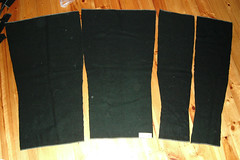Difficulty: Easy
Total Time: 6 hours
The Viking apron dress is a widely debated garment. Many artistic impressions show an apron dress to be made of two rectangular strips of fabric hanging from the oval brooches and sometimes tied at the sides with ribbons much like a tabbard. This reconstruction is highly unlikely, and as yet I have not found any extant research suggesting this method of reconstruction.
There appear to be three styles of apron dress available during the periods that I have been researching (9th-12th centuries). Here they are in a little more detail:
The Peplos
The Finnish Peplos is one of the only complete finds that we are lucky enough to have. This image is from the book "Ancient Finnish Costumes" which seems to be out of print and unfortunately I do not own a copy myself.
It is held up with the brooches and is closely related to the earlier Roman styles. A apron held on with a belt also helps to keep the sides closed as these do not seem to be stitched at all.
This is the only garment I could find that resembles the two panel reconstruction that is most commonly seen in artistic impressions, however it is still quite fitted and practicle due to the manner in which it is worn.
Related Link: Suomalainen muinaispuku (in Finnish)
The Wrap
The wrap apron dress is becomes practicle due to the manner in which it is worn. This style is not open at the sides at all and is made of either one peice which overlaps at the front, or two pieces which overlap at both front and back.
For me personally the singular piece wrap seems most practicle as I imagine that it would be much easier to get on by oneself. Also I imagine that the two peice would need some kind of brooch or fastener on the back straps to hold it together.
This image shows the front panel pulled open so that it is easier to see what is meant by a wrap apron dress.
Related Link: Early Period
The Tube
The Tube dress is the one that I have reconstruced here. This is a simple design and for me seems the most practicle as it is completely enclosed on the sides for warmth and practability when working.
This is still conjecture however, as only fragments have been found of Viking clothing, but it is now believed that this was one of the most common styles of apron dress and this reconstruction is aiming at the 10th century.
This is probably still a development of the peplos.
Related Link: Historiska Varldar
Four panels make up my Viking style apron dress. Here they are laid out on the floor prior to sewing. You can see that it is slightly fitted at the waist and I am considering a little more reduction there to better accentuate natural curves.

The straps that are such an integral part of a "hanging dress" (hangerock) are made of the same green wool and were hand sewn with blanket stitch. I was nearly out of material and just managed to get the two strips out of the small left over pieces.
Here I have shown the first strap nearly complete and both straps complete with the brooches and agate beads that I plan to wear with it. I also have a pair of embroidery shears and a key which will be attached as well. And for all those that want their costimes NOW... its taken me two years to make a dress after my first rough and quick finnish apron dress. I am very happy with how it is turning out though.




No comments:
Post a Comment